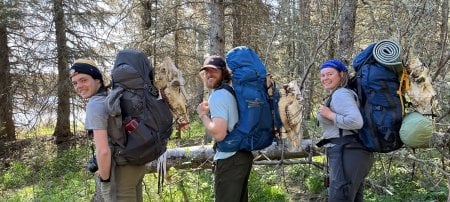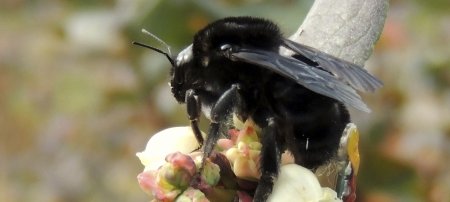Summertime is field season. And while our researchers are out and about, we've been highlighting them each week on #FieldworkFriday. Sometimes to do the actual work, researchers have to travel a long ways.
The Aquatic Ecosystem Ecology Lab is going mobile. And the van is nearly there. There being a remote system of streams and springs in Idaho's Portneuf River watershed. It's full of nitrogen-loving algae that inspires researcher Amy Marcarelli and is the start of a project that will span streams from Puerto Rico to Alaska. The work is part of Marcarelli's National Science Foundation (NSF) CAREER Award.

This summer, Erin Eberhardt and Claire Allison are working with Marcarelli, gathering samples in Idaho and running tests out of the mobile van lab. Here's the start of their #FieldworkFriday story.
The van is packed to the gills for the trip and outfitted with removable countertops, sleeping quarters, and a gas chromatography set-up. Crafted by a team of mechanical engineering students for their senior design project, the mobile lab is customized for the nitrogen sampling Marcarelli, Eberhardt, and Allison do. Basically, they are looking at how much nitrogen gets taken up and altered--or "fixed"--into a chemical form that plants and other living critters can use. Their mobile equipment enables them to test on the road after they gather samples rather than waiting to go back to a lab. The hope for the mobile lab is to turn into a traveling classroom as well so K-12 students can learn about biogeochemistry in their backyard streams and rivers.
By this time next year, the mobile lab's theme song will be Johnny Cash's "I've Been Everywhere."
A stop in Minnesota, of course, wouldn't be complete without Northwoods icons.
"We visited the "homes" of bigfoot and Paul Bunyan and discovered Minnesota really is the land of 10,000 lakes," says Eberhardt, a PhD student in Marcarelli's lab. "There's just vast farmland and prairies—you could see for miles—and it's exciting to see such a different landscape from the northern Midwest."
The changes in landscape from woods to plains to badlands can even be seen in changing crops. As soy and corn give way to wheat and then cattle, the changes reflect precipitation patterns. Understanding these climatic shifts is important for comparing nitrogen fixation across a myriad of sites.
After all, a stream in Michigan is bound to be different from ones in Idaho, Alabama, or New Mexico. Comparing across these systems isn't easy, but showing that nitrogen fixation is indeed happening in many different streams and climates could turn the current nitrogen cycle paradigm on its head. Connecting the dots would show that denitrification, a largely human-driven process now, does not completely stall out nitrogen fixation. (Check out Marcarelli's Unscripted video to learn more on this.)

But long travel for fieldwork isn't all vistas and inspiring views.
"Montana has a lot of Christian rock stations and it is very hard to find "sinful" music."Erin Eberhardt

"Erin received her first ticket ever in Montana for going 86 in an 80 mph zone, even though everyone else was going 90," says Allison, a field technician and Michigan Tech alumnae. "We spent the rest of the day following the speed limit strictly—although, the view was cool where we were stopped, so, yay geology!"
Past the Rocky Mountain Front—and over another half a dozen passes—Eberhardt and Allison watched flyfishermen cast in rivers, rafters prepare boats to fly down white-frothing rapids, and people set up camp. Even with their feet in the water, they were probably not thinking about nitrogen or the slippery nodules of algae hiding under the river rocks. Yet all their activities—from the clarity of water, to the health of fish, to the beautiful mountain views full of trees—are impacted by the nitrogen cycle.
One water sample at a time, the Aquatic Ecosystem Ecology lab team is pushing the boundaries of that cycle's story. From here, it's where the rubber really hits the road.

Michigan Technological University is a public research university founded in 1885 in Houghton, Michigan, and is home to more than 7,000 students from 55 countries around the world. Consistently ranked among the best universities in the country for return on investment, Michigan’s flagship technological university offers more than 120 undergraduate and graduate degree programs in science and technology, engineering, computing, forestry, business and economics, health professions, humanities, mathematics, social sciences, and the arts. The rural campus is situated just miles from Lake Superior in Michigan's Upper Peninsula, offering year-round opportunities for outdoor adventure.







Comments